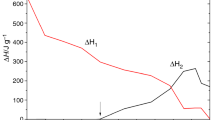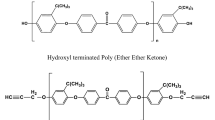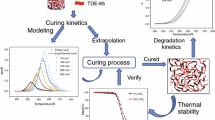Abstract
Non-isothermal curing kinetics of a tetra functional epoxy resin with imidazole-based curing agents was investigated by differential scanning calorimetry (DSC), and decomposition of the cured compounds was studied by thermogravimetric analysis. N,N,N′,N′-tetraglycidyl-4, 4′diaminodiphenylmethane (TGDDM) was cured with three types of tertiary amine curing agents including 1-methyl imidazole (MI), 2-methyl imidazole (2MI) and 2-ethyl 4-methyl imidazole (EMI). These systems exhibited cure initiation at around 70–90 °C by DSC. 2-methyl imidazole and 2-ethyl 4-methyl imidazole showed two cure initiation profiles, while the 1-substituted counterpart, MI, showed a single cure initiation profile by DSC. The Kissinger equation was applied to calculate the apparent activation energy for epoxy–imidazole cure reactions. The rate constants and the pre-exponential factor were also determined. The activation energy varied from 59 to 65 kJ mol−1 for the systems. The Flynn–Wall–Ozawa iso-conversional approach was used to elucidate the activation energies at different extents of conversion during the cure reactions. The cured systems are found thermally stable up to 250 °C. Decomposition kinetics of cured networks was studied using Kissinger equation and Flynn–Wall–Ozawa iso-conversional approach. The cured resins were analyzed for the glass transition temperature and compared with that of a conventional amine-cured system.
Similar content being viewed by others
Explore related subjects
Discover the latest articles, news and stories from top researchers in related subjects.Avoid common mistakes on your manuscript.
Introduction
Epoxy resins constitute the largest segments of addition curable thermosetting polymers that find wide applications in adhesive, coating, laminating, electronic and composite processing industries due to their good mechanical properties and excellent adhesive characteristics [1,2,3,4]. The most commercially exploited epoxy resins are bi-functional ones such as diglycidyl ether of bisphenol A type epoxy resins (DGEBA); however, they possess poor high temperature performance for use in advanced materials sector. Different approaches such as incorporation of aromatic moieties and introduction of epoxy multifunctionality to the backbones are reported to enhance the high temperature resistance of epoxies. The multifunctional epoxy resins cured with suitable hardeners produce matrices with high tensile strength and modulus and high glass transition temperature combined with good thermal and chemical stability [5,6,7,8,9]. They are mainly employed as matrix for high performance fiber-reinforced composites in the aerospace industry and as encapsulant for electronic components. Novolac epoxy resin, cyclo-alphatic epoxy resin, N,N,N′,N′-tetraglycidyl-4, 4′diaminodiphenylmethane, (TGDDM) and resorcinol–formaldehyde are some of the multifunctional epoxy resins reported for industrial applications [10].
The crosslinking of epoxy resins can be effected by step growth and chain growth polymerization techniques. The former make uses of hardeners such as amines, anhydrides, phenols and isocyanates, and the latter is effected using tertiary amine initiators or catalysts [11]. The type of curing agents, composition and the curing conditions employed control the properties of the cured networks like toughness, chemical resistance, mechanical properties, adhesive strength, heat resistance, electrical resistance, etc., of epoxy resins [12]. Among the tertiary amine-based catalytic curing agents, imidazoles are known to be very effective owing to the better heat resistance, higher modulus and tunable cure temperatures compared to a mine-cured systems. Kinetics of the cure reactions of TGDDM with various curing agents such as diaminodiphenylsulfone, diaminodiphenylmethane, dicyandiamide, maleic anhydride and methyl nadic anhydride are widely reported [8, 9], whereas homopolymerization of TGDDM in presence of imidazole curing agents is seldom reported. Hence, the objective of the present study is to investigate the mechanisms of cure reaction, cure kinetics and decomposition kinetics of TGDDM with three different imidazole-based curing agents, viz. 1-methyl imidazole, 2-methyl imidazole and 2-ethyl 4-methyl-imidazole. The cure mechanism and the kinetic parameters for the cure reactions were derived from the DSC analysis and that of decomposition was computed from thermogravimetric analysis.
Experimental
Materials
The epoxy resin, N,N,N′,N′-tetraglycidyl-4, 4′diaminodiphenylmethane and the amine hardener, Jeffamine T403 supplied by Huntsman India Pvt. Ltd. were used as received. 1-methyl imidazole, 2-methyl imidazole and 2-ethyl 4-methyl-imidazole from M/s. Sigma-Aldrich India Pvt. Ltd. was used as the homopolymerization initiators. The structures of epoxy resin and the three imidazole initiators used are shown in Table 1.
Instrumental
The dynamic curing of TGDDM with the three imidazoles was recorded using a differential scanning calorimetric analyzer, TA instruments model 2920. The reaction enthalpy was measured in scanning mode from 30 to 200 °C under nitrogen atmosphere at four different heating rates of 5, 10, 15 and 20 °C min−1 using 10 mg of the sample. The TG curves were recorded using simultaneous thermogravimetric—differential scanning calorimeter, TA Instruments SDT Q-600 equipment in a scanning mode from 30 to 900 °C under nitrogen atmosphere at four different heating rates of 5, 10, 15 and 20 °C min−1. Approximately 6 mg of the sample was used for analysis. The glass transition temperature of the three epoxy–imidazole systems and the epoxy–amine system was evaluated using thermomechanical analyzer using 5 mg of the cured samples.
Computation of kinetic parameters of cure reaction and decomposition
The kinetic model generally employed for the analysis of DSC and TG data is based on equation
where α is the fraction of the reaction completed at time t, A is the pre-exponential factor, E a is the energy of activation, R is the universal gas constant, T is the absolute temperature, and f(α) is the kinetic model function. The Kissinger Eq. 2 was applied to calculate the apparent activation energy E a [13].
where β is the linear heating rate in K min−1, T p is the peak temperature in K. Therefore, a plot of ln (β/T 2p ) versus 1/T p gives the value of E a and A. The Kissinger equation based on peak temperature of the reaction gives only one set of kinetic parameters for the whole reaction. However, the representation of a highly complex reaction by a single E a value does not reveal complete information on the whole reaction. Hence, for a more accurate determination of E a at any given conversion, Flynn–Wall–Ozawa iso-conversion method [14] based on Doyle’s approximation was resorted to. Here energy of activation at a particular conversion is calculated using Eq. 3.
where T α is the iso-conversion temperature, C is a constant, and other parameters are same as described earlier. A plot of log β versus 1/T α gives the value of activation energy at each conversion.
Results and discussion
Cure studies
DSC scanning studies of the cure reaction of TGDDM with stoichiometric quantities of MI, 2-MI and EMI are shown in Fig. 1a–c, respectively, and the associated data are presented in Table 1. TGDDM-MI system showed a single-stage cure profile, whereas the TGDDM-2-MI and TGDDM-EMI showed additional lower temperature peaks along with the main exothermic peak. This observation is in good agreement with the most accepted mechanism proposed by Barton and Shepherd [15] for the polymerization epoxy resin with an 1,3-unsubstituted imidazole viz, 2-ethyl 4-methylimidazole. The schematic for the cure initiation of TGDDM by 2-ethyl 4-methyl imidazole based on the accepted mechanism is shown in Fig. 2, scheme 1. According to this, initially the more basic pyridine-type nitrogen attacks the epoxy group to generate a 1:1 adduct followed by attack of this newly generated adduct on another epoxy group to produce the 1:2 adduct. Vogt [16] in his studies also observed a similar low-temperature peak attributed to the adduct formation steps. The curing of epoxy resins with 1-substituted imidazole embraces much debate and uncertainty about the curing mechanism. The schematic for the cure initiation of TGDDM by 1-methyl imidazole based on the accepted mechanism by Dearlove [17] is shown in Fig. 2, scheme 2. Here, unlike the case of 1, 3-unsubstituted imidazoles, the initiating species is a 1:1 adduct which proceeds further with the homo polymerization of epoxy molecules.
The cure initiation temperature, T i, increases with increase in heating rate for each epoxy–imidazole system and follows the order of TGDDM-EMI > TGDDM-2-MI > TGDDM-MI at each of the heating rate as shown in Fig. 3.
The DSC curves of TGDDM-2MI showed a meager transition for the adduct formation reaction and the intensity of which vanishes at higher heating rate. However, in the case of TGDDM-EMI system, a prominent transition was observed for the adduct formation (AF) and the polyetherification (PE) steps, and hence both curves were considered separately for calculating the kinetics. This difference may be attributed to the difference in the substituent attached to 2nd and 4th position on the imidazole ring. Based on the inductive effect, the ethyl group and methyl groups push the electron cloud density toward the active nitrogen, thereby enhancing the formation of 1:1 adduct.
The structure and the reactivity of the curing agent, steric restriction to the epoxy–amine reaction and physical interactions among the different functional groups of constituent components influence the cure kinetics. Even though the nucleophilicity of the nitrogen atom is high for EMI, its highest cure initiation temperature is attributed to the steric hindrance imparted by the ethyl and methyl substitution of the imidazole. The Phenomenological data of curing reactions from DSC experiments at different heating rates are given in Table 2.
Cure kinetics
The kinetic plots for the three epoxy–imidazole systems based on Kissinger method are given in Fig. 4. The kinetic parameters viz, activation energy E a, pre-exponential factor A and rate constant k were calculated from the kinetic plots and are given in Table 3.
The activation energies of all these systems are comparable as evident from Table 2. The Flynn–Wall–Ozawa (FWO) iso-conversional approach has been used for elucidating the dependence of activation energy of TGDDM-imidazole reaction on the relative conversion. Figure 5a–c depicts the percentage conversion versus temperature at four different heating rates of TGDDM with MI, 2-MI and EMI systems. In all cases, the percentage conversion increases with temperature and reaches a plateau at about 96–98% conversion.
Determination of activation energy by the FWO iso-conversional method is illustrated in Fig. 6. A linear relationship between Ln β and 1/T can also be observed for the three epoxy–imidazole systems.
Figure 7 exhibits variation of activation energy with increasing percentage conversion for the epoxy imidazole systems studied. For the adduct formation step of TGDDM-EMI reaction, the activation energy remains constant for the entire range of conversion, whereas it decreases with conversion during further polyetherification reaction. The TGDDM-IMI and TGDDM-2MI systems also show a similar trend of reduction in activation energy with conversion. This is attributed to the autocatalysis of the polyetherification reaction by the alkoxide ion generated during the initial adduct formation reaction. A similar observation has been made by Yang et al. [18] during the curing of epoxy-CNT nanocomposite using 2-ethyl 4-methyl imidazole as the catalyst. Thus, the autocatalytic effect rendered by the alkoxide ion intermediate decreases the overall activation energy during the polyetherification.
Thermal decomposition kinetics
Figure 8 represents the decomposition curves of TGDDM-MI, TGDDM-2MI and TGDDM–EMI systems for a particular heating rate of 10 °C min−1. All the three systems showed similar decomposition curve and are found thermally stable up to 300 °C. The phenomenological data of the three systems subjected to TG analysis at heating rates of 5, 10, 20 and 40 °C min−1 are summarized in Table 4.
Thermal decomposition of cured epoxy–imidazole systems appears to conform to a one-step reaction mechanism for all the epoxy–imidazole systems. The char residue obtained at 900 °C in nitrogen atmosphere for all the systems is comparable.
The kinetic plots for the thermal decomposition of three epoxy–imidazole systems based on Kissinger method are given in Fig. 9. The activation energy, pre-exponential factor and rate constant calculated by Kissinger methods using DTG peak temperatures are tabulated in Table 5. The activation energy derived for the systems is comparable signifying more or less similar thermal stabilities.
TGDDM epoxy resin was cured with the three imidazole initiators and the Jeffamine T403 hardener as per the respective cure profile obtained from DSC analysis and analyzed for its glass transition temperature (T g). The epoxy imidazole systems failed to show a clear transition in the DSC analysis which may be due to its high crosslink density rendered by the tetra functional epoxy resin. Hence, the cured resins were subjected to thermomechanical analysis and the T g obtained is shown in Table 6. It is observed that the imidazole-cured systems showed an enhanced glass transition temperature in the range of 141–154 °C than the conventional amine-cured system which showed a T g of only 125 °C. The glass transition temperature gives an indirect indication on the polymer chain stiffness and shows the service temperature capability of the cured resin. The present study shows that that the imidazole curing agents can render enhanced chain stiffness and service temperature capability than the conventional amine-cured systems.
Conclusions
The cure reactions and the associated kinetic parameters of curing of a tetrafunctional epoxy resin, N,N,N′,N′-tetraglycidyl-4, 4′diaminodiphenylmethane, (TGDDM) with three different types of imidazole tertiary amine catalysts, viz. 1-methyl imidazole (MI), 2-methyl imidazole (2MI) and 2-ethyl 4-methyl imidazoles (EMI) were investigated using differential scanning calorimetry, and decomposition kinetics of the cured systems were studied using thermogravimetric analysis (T g). Single-stage curing was observed in the case of TGDDM-MI, whereas TGDDM-2MI and TGDDM-EMI exhibited multimodel curing curves owing to the difference in the cure pathways. The epoxy–imidazole systems showed comparable activation energy values and varied from 59 to 65 kJ mol−1. The Flynn–Wall–Ozawa iso-conversional approach was used to elucidate the activation energies at different extents of conversion during the cure reactions. In all the cases, activation energy showed a reducing trend with respect to conversion. The cured systems are found thermally stable up to 250 °C. Decomposition kinetics of cured networks was studied using Kissinger equation and Flynn–Wall Ozawa (FWO) iso-conversional approach.
References
Jin FL, Li X, Park SJ. Synthesis and application of epoxy resins: a review. J Ind Eng Chem. 2015;29:1–11.
Weil ED, Levchik S. A review of current flame retardant systems for epoxy resins. J Fire Sci. 2004;22:25–40.
Sprenjer S. Epoxy resin composites with surface-modified silicon dioxide nanoparticles: a review. J Appl Polym Sci. 2013;130(3):1421–8.
Rafique I, Kausar A, Anwar Z, Muhammad B. Exploration of epoxy resins, hardening systems, and epoxy/carbon nanotube composite designed for high performance materials: a review. Polym Plast Technol. 2016;55(3):312–33.
Mustata F, Bicu I. Multifunctional epoxy resins: synthesis and characterization. J Appl Polym Sci. 2000;77(11):2430–6.
May CA. Epoxy resins, chemistry and technology. New York: Marcel Dekker; 1988.
Cheng J, Li J, Zhang JY. Curing behavior and thermal properties of trifunctional epoxy resin cured by 4, 4′-diaminodiphenyl sulfone. Expr Polym Lett. 2009;3(8):501–9.
Qiu SL, Wang CS, Wang YT, Liu CG, Chen XY, Xie HF, Huang YA, Cheng RS. Effects of graphene oxides on the cure behaviors of a tetrafunctional epoxy resin. Expr Polym Lett. 2011;5(9):809–18.
Yu M, Feng B, Xie W, Fang L, Li H, Liu L, Ren M, Zhnag J, Sun J, Hu H. The modification of a tetrafunctional epoxy and its curing reaction. Materials. 2015;8(6):3671–84.
Unnikrishnan KP. Doctoral Dissertation, Cochin University of Science and Technology, India 2006.
Prolongo SG, Prolongo G. Epoxy/poly (4-vinylphenol) blends crosslinked by imidazole initiation. J Therm Anal Calorim. 2007;87(1):259–68.
Potter WG. Epoxide resins. New York: Springer; 1970.
Kissinger HE. Reaction kinetics in differential thermal analysis. Anal Chem. 1957;29:1702–6.
Flynn J, Wall L. A quick, direct method for the determination of activation energy from thermogravimetric data. J Polym Sci Polym Lett. 1966;4(5):323–8.
Barton JM, Shepherd PM. The curing reaction of an epoxide resin with 2-ethyl-4-methylimidazole, a calorimetric study of the kinetics of formation of epoxide-imidazole adducts. Makromol Chem. 1975;176:919–30.
Vogt J. Thermoset matrices for structural adhesives: imidazole-catalysed curing of epoxy resins. J Adhesion. 1987;22:139–51.
Dearlove TJ. A comparison of some imidazole catalysts as epoxy curing agents. J Appl Polym Sci. 1970;14:1615–26.
Yang BK, Gu M. Fabrication. Morphology and cure behavior of triethylenetetramine-grafted multiwalled carbon nanotube/epoxy nanocomposites. Polym J. 2009;41(9):752–63.
Acknowledgements
The authors thank Director, Vikram Sarabhai Space Centre and Deputy Director, VSSC (PCM) for their permission to publish this work.
Author information
Authors and Affiliations
Corresponding author
Rights and permissions
About this article
Cite this article
Leena, K., Soumyamol, P.B., Baby, M. et al. Non-isothermal cure and decomposition kinetics of epoxy–imidazole systems. J Therm Anal Calorim 130, 1053–1061 (2017). https://doi.org/10.1007/s10973-017-6410-5
Received:
Accepted:
Published:
Issue Date:
DOI: https://doi.org/10.1007/s10973-017-6410-5













